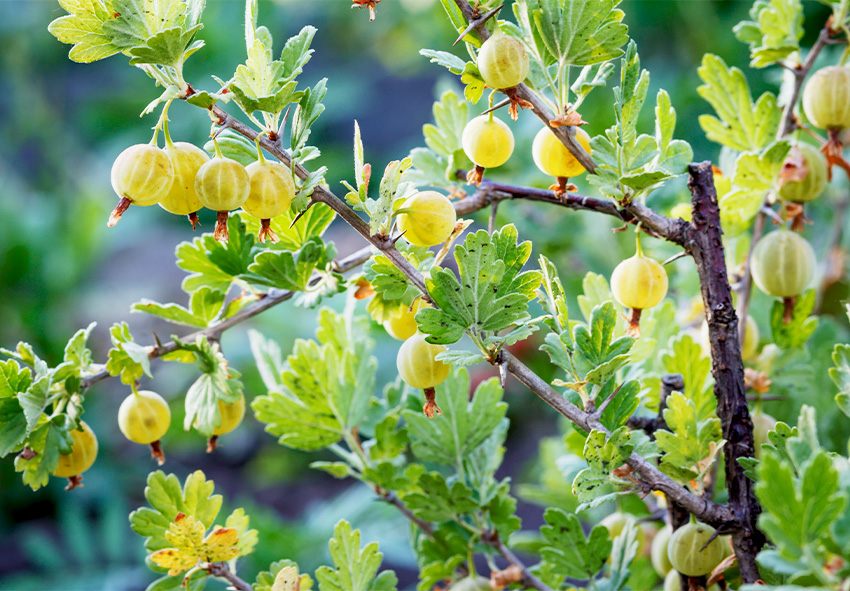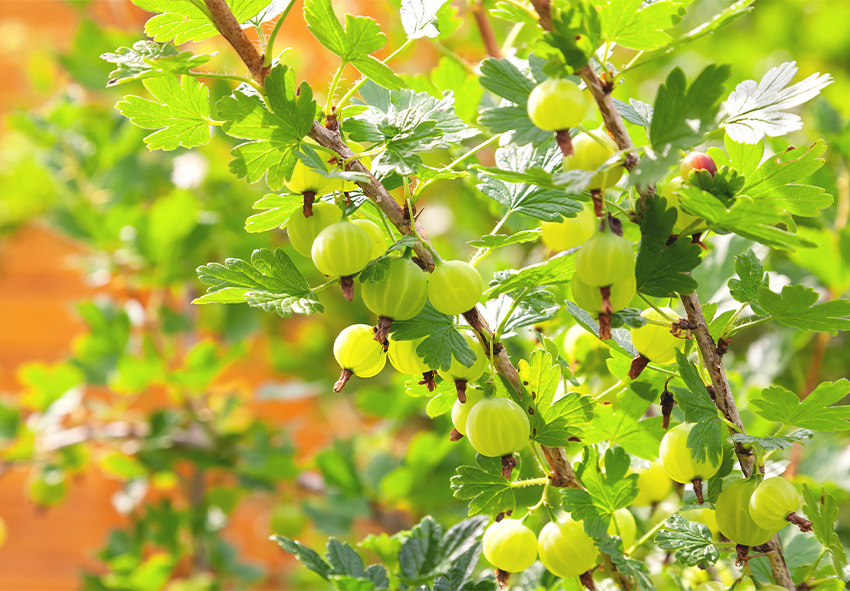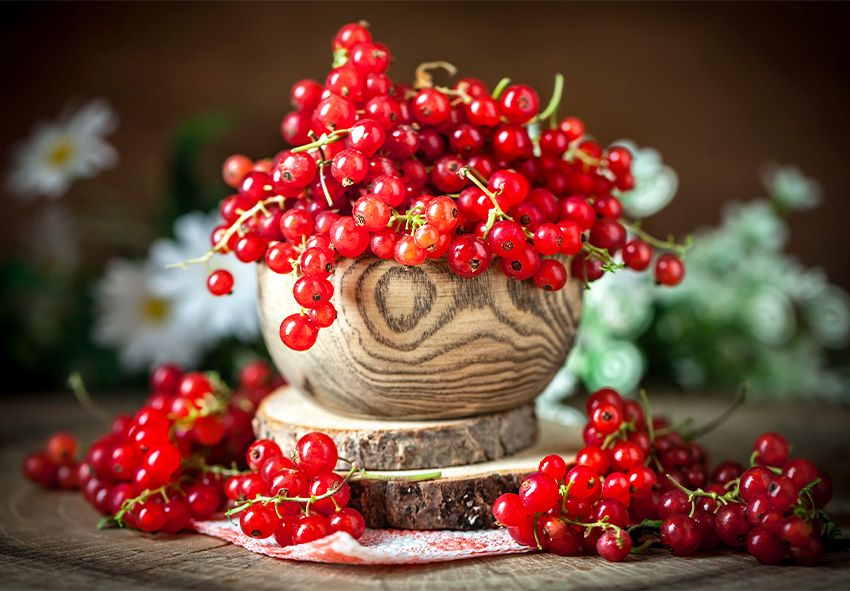Gooseberries are gaining popularity among home gardeners thanks to their unique tart-sweet flavor, high yields, and adaptability to various climates. With a wide selection of gooseberry varieties available, it’s easier than ever to find one that suits your taste and garden conditions. In this guide, we’ll explore the top gooseberry varieties — like Hinnonmaki Yellow, Spinefree, and Malakhit — and provide practical tips for planting, growing, and harvesting them successfully. Our gardening blog is a perfect place to find all the information you need!
Factors to Consider When Choosing a Gooseberry Variety

Selecting the right gooseberry variety is essential for a thriving harvest. From climate conditions to culinary use, various factors affect which variety will perform best in your garden. Here’s what to consider before planting.
Climate and Hardiness Zones
Gooseberries thrive in cooler climates but can be grown in a range of USDA zones, typically zones 3–8. Some varieties, like Hinnonmaki Yellow, are especially hardy and perfect for colder regions. Always check the cold-hardiness and heat tolerance of each variety before planting.
Flavor Profile and Use
Do you prefer a sweet berry for snacking or a tart one for making jam? Gooseberries range from mildly sweet to sharply tart. Knowing how you plan to use them — fresh eating, baking, or preserving — can help you choose the best flavor profile.
Growth Habit and Maintenance
Some gooseberries grow as compact bushes, while others spread more widely. Consider the plant’s growth habit, whether it’s thornless like Spinefree or more traditional with spines. Also, choose varieties known for disease resistance and low maintenance.
Top Gooseberry Varieties to Grow
With so many types of gooseberries available, it’s helpful to focus on varieties that offer excellent yield, flavor, and resistance to common issues.
Hinnonmaki Yellow
This Finnish variety features small to medium yellow berries with a sweet-tart flavor. Hinnonmaki gooseberry is a compact, hardy plant perfect for colder regions and beginner gardeners.
- Preferred Climate: Thrives in cooler climates (USDA Zones 3–7). Handles cold winters exceptionally well and also prefers partial to full sun.
- Usage: Excellent for fresh eating thanks to its sweet flavor. Ideal for jams, pies, and preserves.
- Advantages: Cold-hardy and reliable even in northern climates, high resistance to mildew and pests, great for small spaces and container gardening.
Spinefree
A red berry with few or no thorns, Spinefree gooseberry produces medium to large berries with a sweet, juicy flavor. It’s popular for both culinary and fresh-eating purposes.
- Preferred Climate: Grows well in temperate to slightly warmer climates (USDA Zones 4–8). Tolerates partial shade but prefers full sun. Also suitable for areas with mild winters.
- Usage: Perfect for fresh snacking due to sweet flavor. Also great for sauces, desserts, and freezing.
- Advantages: Thornless stems for comfortable harvesting, sweet fruit ideal for a variety of uses, good disease resistance and low maintenance.
Malakhit (Malachite)

This Russian variety bears medium-sized, translucent green berries with a strong tart flavor. Malakhit gooseberry is loved for its productivity and rugged resilience.
- Preferred Climate: Performs best in cool to moderate climates (USDA Zones 3–7) and especially well-suited to cold regions and high altitudes. Also handles unpredictable weather well.
- Usage: Perfect for jams, jellies, and baking due to tartness. Also good for freezing and preserving, but not ideal for eating raw unless fully ripe.
- Advantages: Very hardy and tolerant of cold conditions, high yield and vigorous growth and strong resistance to powdery mildew.
Invicta
Invicta is a green gooseberry known for its large, firm fruits and vigorous growth. It’s one of the most productive and widely planted varieties in Europe.
- Preferred Climate: Ideal for temperate climates (USDA Zones 4–8). Does best in full sun but tolerates light shade. Also requires good air circulation for best results.
- Usage: Excellent for cooking and preserving due to tart flavor. Commonly used in pies, chutneys, and syrups.
- Advantages: High yield and large berry size, vigorous and fast-growing and strong resistance to mildew and pests.
Captivator
Captivator is a hybrid variety with red berries and mostly thornless canes. The fruit is sweet and soft, making it a favorite for fresh use and freezing.
- Preferred Climate: Thrives in USDA Zones 3–7 and tolerates both cold winters and warmer summers. Prefers sunny spots with good drainage.
- Usage: Great for eating fresh, freezing, and making jelly.
- Advantages: Self-fertile, easy to grow and resistant to powdery mildew. Also easy to pick due to the lack of thorns.
Growing and Caring for Gooseberries
Caring for gooseberries isn’t difficult, but they do have specific needs to ensure abundant harvests. From planting to pruning, here are key steps to follow.
Planting Tips
Plant gooseberries in early spring or fall when the weather is cool. Choose a location with full sun to partial shade and well-draining soil. Space plants about 3–5 feet apart to allow good air circulation and room to grow.
Watering and Fertilization
Keep the soil evenly moist, especially during fruit development. Avoid overwatering, which can lead to root problems. Use a balanced fertilizer in early spring to encourage strong growth and higher yields.
Pruning and Maintenance
Prune your gooseberry bushes annually during dormancy to improve air circulation and fruit production. Remove any dead or crossing branches. Keep the area around the plants weed-free to reduce disease risk.
Harvesting and Using Gooseberries

Knowing when and how to harvest your gooseberries ensures peak flavor and easy picking. Most varieties ripen between early summer and mid-July.
When to Harvest Different Varieties
Ripe gooseberries should be firm but slightly soft when gently squeezed. Hinnonmaki Yellow and Malakhit typically ripen earlier, while varieties like Captivator may mature a bit later. Color and touch are your best indicators.
How to Use Gooseberries in the Kitchen
Gooseberries are incredibly versatile in the kitchen. Use them in jams, crumbles, tarts, or enjoy them fresh. They also freeze well for year-round use, making them a valuable fruit for preserving.
Conclusion
With their distinctive flavor, ease of care, and adaptability, gooseberries are a must-have for any fruit lover’s garden. Whether you’re drawn to the sweet flavor of Spinefree or the tart richness of Malakhit, there’s a gooseberry variety for every grower. Ready to get started? Browse our online store for top-quality gooseberry plants and all the gardening tools you need for a successful harvest!
Frequently Asked Questions (FAQs) about Gooseberries
1. Which gooseberry is easiest to grow for beginners?
Spinefree is ideal for beginners thanks to its thornless stems and low-maintenance growth. It’s sweet, versatile, and resistant to most common pests and diseases. It also thrives in a wide range of climates, making it suitable for many home gardens.
2. Can I order gooseberry plants from your online store?
Yes! You can browse our online store Dutch-bulbs.com and order top gooseberry varieties like Spinefree, Hinnonmaki Yellow and Malakhit. We offer healthy plants ready for shipping with growing tips to help you succeed in your garden.
3. Can I grow gooseberries in containers?
Yes, varieties like Hinnonmaki Yellow and Captivator are compact and well-suited for container gardening. Use a deep, well-draining pot and ensure your plant gets at least 6 hours of sunlight daily. Regular watering and feeding will keep container-grown gooseberries productive.
4. What is the best gooseberry variety for cold climates?
Hinnonmaki Yellow and Malakhit are excellent choices for colder regions. Both are extremely hardy and can tolerate frosty conditions. Hinnonmaki Yellow is especially popular in northern climates due to its sweet flavor and resistance to diseases like powdery mildew.
5. Are gooseberries good for cooking and preserving?
Absolutely! Tart varieties like Malakhit and Invicta are perfect for jams, pies, chutneys, and syrups. Their firm texture holds up well in cooking, while sweeter types like Captivator are great for fresh use and freezing.
Published: 04.07.2025
